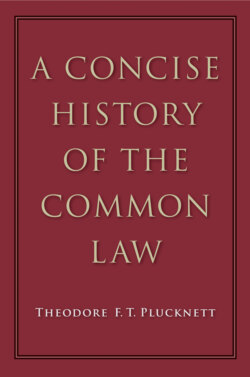Читать книгу A Concise History of the Common Law - Theodore F. T. Plucknett - Страница 98
На сайте Литреса книга снята с продажи.
CHAPTER 4 THE JURY SUMMARY
Оглавление1. Early prototypes of the jury
Supposed Anglo-Saxon Origins
English and Scandinavian Juries
2. The jury for royal administrative inquiry
Frankish Juries
3. The jury for the trial of property cases
Norman Juries and Assizes
Inquisitions in England
Assizes in England
4. The jury for royal criminal inquiry
Criminal Law: The Grand Jury
5. Ancient modes of trial
The Ordeals
Wager of Law
Trial by Battle
Abolition of the Ordeal
6. The jury as a new mode of trial
Evolution of the Petty Jury
An Example of the New Criminal Procedure
Trials on Indictment
The Inscrutable Jury
Jury Trial becomes Compulsory
Rationalisation of Jury Trial
The Jury as Representatives
Early Opinion about the Jury
The Early History Summarised
7. Post-mediaeval problems
The Review of Verdicts
The Punishment of Obstinate Jurors
Bushel’s Case
New Trials
Constitutional Position of the Jury
It is in this complicated interplay of royal and local institutions that the origins of the jury are to be sought; so we can now appropriately turn from the study of the vill and the hundred to the growth of the system of presentment which was so prominent a part of their constitution, and to the later transformation of that system into a method of trial as well as accusation. At the same time, the county’s loss of effective jurisdiction over pleas of land was intimately connected with the rise of the royal writ, and this will be almost synonymous with the use of an assize or a jury of twelve. The criminal jury, therefore, can be treated here because it grew out of the natural expression of the vill and the hundred; but the civil jury in the old real actions was based (as we shall see) upon a somewhat different, though related, idea, which only came to an end with the abolition of real actions. The modern civil jury, it must be remembered, is descended from the old criminal jury through the action of trespass, which was at first partly criminal and later entirely civil in its character.
The discussion may well open with Maitland’s definition of the jury: a jury is a body of neighbours summoned by a public officer to answer questions upon oath.1 It will be seen that there is nothing in this definition which restricts the jury to judicial proceedings; on the contrary, the definition deliberately makes room for the fact that the jury, like so many institutions, was an administrative device which only later became confined to courts of law.
The story is complicated because several different lines of development were being pursued simultaneously, and so it is particularly necessary to have the outlines clearly in mind while the details of this chapter are being studied. The subject will be dealt with in the following order:
1 Early prototypes of the jury;
2 The jury for royal administrative inquiry;
3 The jury for the trial of property cases;
4 The jury for royal criminal inquiry;
5 Ancient modes of trial;
6 The jury as a new mode of trial;
7 Post-mediaeval problems.
